Preparation of masonry mortars
Since various types of mixtures can be used for the masonry composition, we will consider in more detail how to prepare a mortar for laying bricks.
Cement slurry proportions
Sand-cement compositions are widespread in capital construction and other areas where increased requirements are imposed on the strength characteristics of brickwork.
Before preparing a masonry mortar, it should be remembered that an excess of cement in the working mixture does not increase its strength, and in some cases even worsens its characteristics. Only strict adherence to the dosage will ensure the optimal performance of the masonry mixture. The proportions of the most common cement-based compositions are given in SP 82-101-98, which clearly regulates the percentage of ingredients in various types of cement masonry mixtures.
The table shows the percentage of ingredients in the masonry mortar, depending on the grade of cement used.
|
Masonry mixture brand |
Cement grade |
Ratio cement / sand |
|
M25 |
M300 |
1/9,5 |
|
M50 |
M300 |
1/5,8 |
|
M400 |
1/7,4 |
|
|
M 75 |
M 300 |
1/4,2 |
|
M 400 |
1/5,4 |
|
|
M 500 |
1/6,7 |
|
|
M 100 |
M 300 |
1/3,4 |
|
M 400 |
1/4,3 |
|
|
M 500 |
1/5,3 |
|
|
M 150 |
M 300 |
1/2,6 |
|
M 400 |
1,3,25 |
|
|
M 500 |
1/3,9 |
Scope of application of cement mortar, depending on the strength characteristics
Below is the scope of application of various grades of masonry mortars.
- M25. Used for plastering and floor screed. The composition does not contain any additional ingredients.
- M 50. It is used for brick and masonry in the construction of low-rise buildings and structures. May contain plasticizers, colorants and other additives.
- M 75. It is used for laying concrete slabs, installing reinforced concrete structures, erecting internal partitions and installing a concrete floor screed.
- M 100. It is widely used in monolithic construction, masonry work and pouring lightly loaded strip foundations.
- M 150. It is mainly used for foundation work on loose soils.
Proportions of cement-lime mortar
The percentage of cement, lime and sand in the cement-lime mortar is shown in the table.
|
Cement / lime / sand ratio |
|||||
|
Cement grade |
Masonry mix M 50 |
Masonry mix M 75 |
Masonry mix M 100 |
Masonry mix M 150 |
Masonry mix M 200 |
|
M 300 |
1/0,6/8 |
1/0,3/4 |
1/0,2/3,5 |
1/0,1/2,5 |
|
|
M 400 |
1/0,9/8 |
1/0,5/5,5 |
1/0,4/4,5 |
1/0,2/3 |
1/0,1/2,5 |
|
M 500 |
1/0,8/7 |
1/0,5/5,5 |
1/0,3/4 |
1/0,2/3 |
The solution is prepared in the following sequence:
- Lime-fluff is diluted to the consistency of kefir, after which it is filtered.
- A dry sand-cement mixture is prepared separately.
- The strained lime is added to the cement-sand mixture and thoroughly mixed until a homogeneous mass is obtained.
Proportions of cement-clay mortar
The ratio of cement, clay and sand in the cement-clay masonry mixture is shown in the table.
|
Masonry mixture brand |
Cement M 500 |
Cement M 400 |
Cement M 300 |
|
Cement / clay / sand ratio |
|||
|
M 300 |
1/0,15/2,1 |
1/0,07/1,8 |
|
|
M 200 |
1/0,2/3 |
1/0,1/2,5 |
|
|
M 150 |
1/0,3/4 |
1/0,2/3 |
1/0,1/2,5 |
|
M 100 |
1/0,5/5,5 |
1/0,4/4,5 |
1/0,2/3,5 |
|
M 75 |
1/0,8/7 |
1/0,5/5,5 |
1/0,3/4 |
|
M 50 |
1/0,9/8 |
1/0,6/6 |
|
|
M 25 |
1/1,4/10,5 |
The addition of clay increases the moisture retention capacity of the masonry mix.
The low strength of the lime mortar prevents its widespread use in masonry work. Most often, lime mixtures are used for plastering work. The proportions of the working solution depend primarily on the fat content of the lime and can range from 1/2 to 1/5.
Application and consumption
Plastering the surface is carried out in several ways:
- With your own hands. In this case, the techniques of scattering or smearing are used. When spreading on a trowel or on a trowel, the material is placed, then the tool is brought to the surface at an angle. A layer of plaster tarmac is thrown, and the trowel comes off sharply from the wall, but for this it is better to practice a little. Spreading on the base is carried out with a spatula, and this makes the task a little easier for beginners.It turns out that the material is initially applied to the tool, and then smeared on the wall surface.
- Specialized units - mortar pumps. The mixture is pumped by a compressor unit through a hose with a nozzle on the base, and supplied to the surface to be treated. As a rule, this method is used for large building volumes.
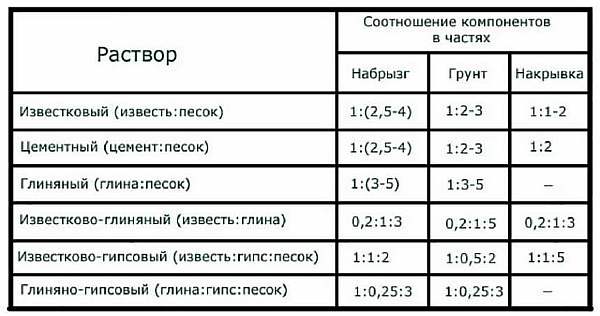 Ratio of components in parts
Ratio of components in parts
Material consumption depends on the thickness of the applied basting, that is, it turns out that the more irregularities, the more mixture must be prepared. You can independently calculate the amount of material for plastering operations. For this, the following indicators are taken into account:
- type of mortar mixture;
- constituents of the mixture, including a plasticizer;
- evenness of the bases;
- material of the surfaces to be plastered.
If the house is multi-storey, then the deviation in the plane is about 2 cm. To reduce the plaster layer, primer treatment is necessary. To determine the thickness of the layer, you need to determine the curvature of the surface. For this:
- It is required to lower the plumb line from the ceiling, find the most protruding point and measure the thickness from the found point to the base.
- Beacon rails are stuffed, and depressions become known relative to them.
 Detailed list and proportions
Detailed list and proportions
For example, the wall has an area of 12 m2, and with the help of lighthouses it was found out that on the plane - 2, 5, 3 cm.Then all the indicators add up, and it turns out that (2 + 5 + 3): 3 = 3.3 cm. This will be the thickness of the layer.
Plastering
Sequence of work:
- To begin with, the surface must be prepared, that is, make incisions in concrete or brick, if necessary. Do not forget to treat it from rust and oil inclusions. Then the surface must be moistened with water: this will provide better adhesion.
- Application of the first layer, i.e. spraying. The layer should set a little before applying the next one.
- With the help of the rules, the mixture is smoothed - up, on the sides, but in no case down: so the outline will only fall off the wall.
- The next layer is a primer. It is applied in the same way as the previous one, and then it is leveled with a rule or a polisher.
- Now the composition is on the wall, and then it is necessary to perform the finishing operation - grouting. To do this, take a grater and grind the base until smooth. The solution must be used more liquid.
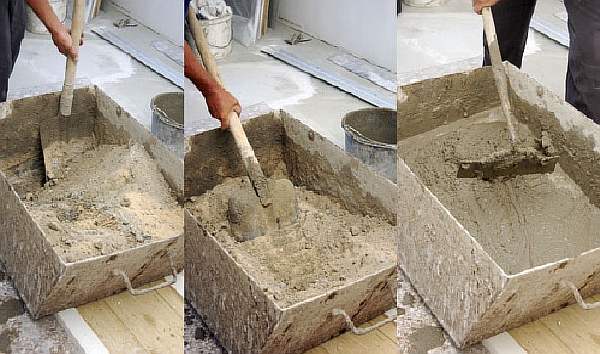 Kneading
Kneading
Everything is easy to do with your own hands, but before that it is worth a little practice.
Consumption
The consumption of the mixture is indicated on the packaging by the manufacturer, while the plaster layer is taken at 10 mm.
The thickness is multiplied by the square meters of the surface to be treated. This is how the flow rate is calculated.
Properties
The main properties of cement-lime mortars:
- mobility;
- the ability of the solution to retain water should be from 90%;
- the delamination of the prepared mixture should be up to 10%;
- application temperature up to 0 degrees;
- average density;
- humidity (this parameter is used only for dry mortar mixtures).
The composition of the mixture is selected depending on the type of material on which it will be applied, and on the conditions for further operation of the finished coating.
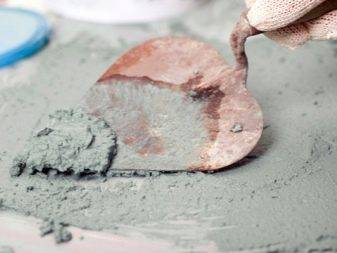
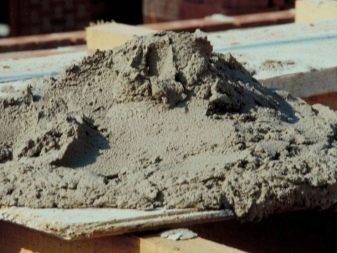
There is such a thing as the fat content of the finished mixture. Fat content depends on the amount of astringent included in the composition.
Cement-lime mortars are divided into three categories of fat content.
- Normal - these are solutions with such plasticity, which is most universally suitable for use in various conditions. In solutions with such a fat content, shrinkage and, as a result, cracking of the finished coating do not occur.
- Lean are mortars with minimal shrinkage. They are ideal for tiling work.
- Fatty are mixtures with a high degree of plasticity, which is due to the large number of astringents that make up the composition. This material is best used for masonry work.
Thus, you can easily adjust the plasticity of the finished solution and adjust its properties for specific operating conditions.
Varieties of plaster mixes for brick walls
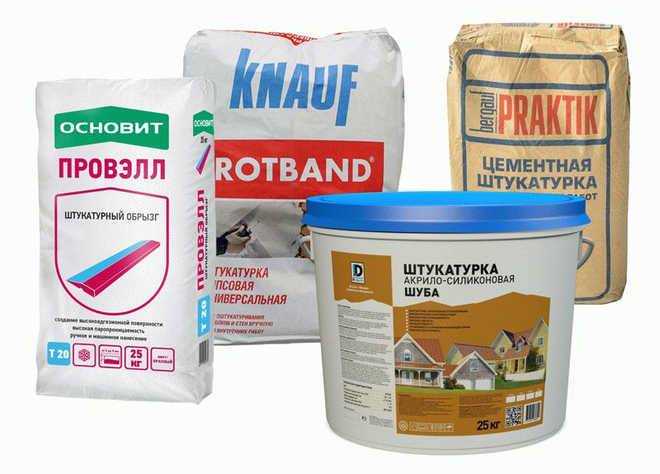
By the type of the most commonly used compositions, plaster mixes for brick walls are divided into simple compositions, namely:
- Cement.
- Calcareous.
- Products intended for gypsum plastering.
There are dry mixes on sale that can be used to plaster walls, consisting of several components:
- Cemento-sandy.
- Cement-lime.
- Clay-limestone and a number of others, which can be used to process walls made of silicate bricks.
Let's take a look at the plastering compounds that can be used on brickwork.
Cement-sand plaster mixes
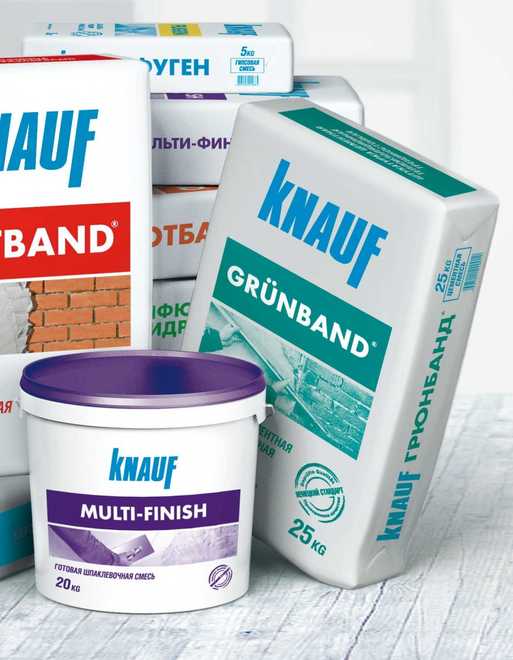
Considering this composition for plastering, we can say that it is universal. It is used for indoor and outdoor work. Advantages:
- Durability. It can last up to 30 years.
- Acceptable cost of the composition for plastering brick walls in comparison with other materials.
- Plastic. The layer can be adjusted within a few hours.
- Resistance to negative t and high humidity. Cement-based renders and sands are often used in kitchens, bathrooms and offices where humidity is high.
However, with all the positive properties, the plaster mixture for brick walls in question has negative qualities:
- It is necessary to study well the technology of its application to brickwork.
- The work takes a lot of effort.
- The plaster solution applied to the work surface dries for a rather long time.

It is important to consider the nuances:
- For example, the thickness of the plaster layer for brick walls should not exceed 30 mm.
- To apply a layer of more than 3 cm, it is necessary to use a reinforcing material.
- When processing the facade of a brick building, lime is added to the cement-sand plaster mixture.
Plaster mixes for plastering brick walls
Plaster-based plastering compounds are a guarantee that brick walls will breathe due to their high vapor permeability. To improve plasticity and increase adhesion, gypsum is added to the composition. Due to the use of gypsum, it is possible to achieve an increase in the thermal insulation properties of the plaster mortar. Gypsum absorbs excess moisture from the walls, thereby improving the indoor climate.
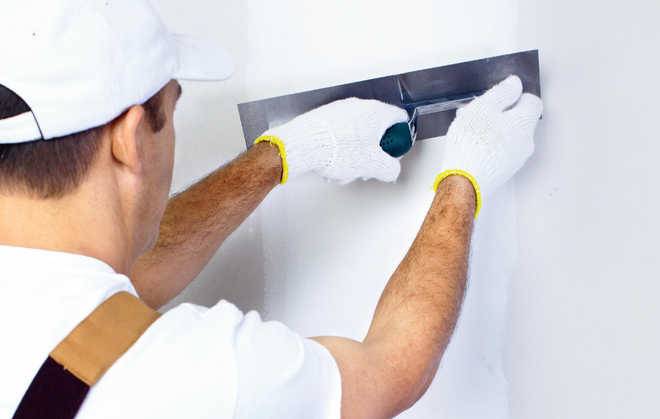
Decorative mixtures for plastering brick walls
A mixture for brickwork looks advantageous. The plastering solution is applied to a previously prepared surface. The decorative solution has a number of advantages:
- Wall surfaces treated with decorative plaster look attractive and aesthetically pleasing.
- The use of a decorative solution allows us to talk about an improvement in water-repellent properties.
- It is worth mentioning the antiseptic qualities of the decorative mixture for plastering.
There are a number of technologies to give texture and relief to the walls. Most often, the basic component is synthetic resin. Various additives are used to give a beautiful appearance.
What solution is needed for plastering the walls.
A practical, reliable and inexpensive finish is wall plastering with cement mortar. The technical characteristics made the cement popular. True, it is not applicable everywhere.
Grade of mortar for plastering walls.
The brand is determined by the permissible compression ratio of the hardened and completely dried (28 days) solution. Adjusted by the ratio of binder and fillers. As the latter, sawdust, fine slag, polystyrene granules, perlite, etc. are used. But most often it is quarry or river sand.
The choice of the brand is associated with the peculiarities of the plaster (external, internal, light, waterproof, heat-insulating) and the purpose of a specific layer in the general structure of the plaster array (spray and soil, cover). The composition of the base is of decisive importance.
M50. Light. Recommended for grouting only when plastering
The strength of the layer is not so high, but the shrinkage is also minimal, which is important when applying the finishing plaster.
Proportions: when using M400 cement - 1: 6.3 (for 1 hour of cement, 6.3 parts of sand).
- M100. A denser compound that is used for interior wall decoration.
Proportions: 1: 5.
- M150. For interior decoration in damp and damp rooms, for plastering facades and plinths of buildings.
Proportions: 1: 3.
Consumption rate of cement-sand mortar for wall plastering.
It is easy to calculate the consumption of cement mortar per 1 m2 of plaster. It is necessary to multiply the thickness of the layer by the area of the working surface.
- Minimum plaster thickness. Not less than 6mm (the size of the protruding part of the lighthouse).
- The maximum value is tied to the curvature of the wall. Plaster can reach several centimeters on one side of the plane, and 6 mm on the other.
The slope is calculated as follows:
- The entire plane of the wall is hung, the slope of arbitrary points is measured. The more such points, the more accurate the calculations. For example, 1, 2, 4 cm.
- All recorded deviations are summed up: 1 + 2 + 4 = 7.
- The amount is divided by the number of measurements: 7: 3 = 2.3cm - the average thickness of the plaster.
- The average is multiplied by the area of a particular wall.
Cement mortar for plastering walls is prepared in different proportions than concrete of the same brand. This is due to the difference in fillers: crushed stone is used for concrete, but not for mortars.
The strength of the plaster depends not only on the saturation of the mixture with binder.
Cement mortars
Cement is prepared from a mixture of ordinary cement and medium-fraction sand. The proportions can be different, they depend on the brand of cement used and can be: one part of the cement is taken from three to six - sand.
Stir the dry mixture with the addition of water until a homogeneous mass is formed.
First, the dry mixture is kneaded, after that water is gradually added, then everything is mixed until a homogeneous, thick mass is obtained. But this option is not the best, since ordinary cement is inactive, even when using any brands, it turns out to be too tough, too strong.
Cement-lime mortar for brickwork consists of lime and cement. The cooking process is as follows:
- Slaked lime, that is, lime dough, is diluted to the state of thick milk, after which it is filtered through a sieve.
- On the basis of sand and cement, a dry mixture is prepared, which is dissolved with milk of lime, and then thoroughly mixed. The addition of lime can increase the plasticity of the resulting batch; such a mixture is recommended to be used for laying bricks of any type.
Simple mortar for masonry
The simplest solution is prepared from a binder (it can be ordinary cement or lime) and sand. In some cases, clay can also act as a binder, but this is a very highly specialized work that is not done so often.
The most common cement-sand mortar has the following proportions: one part of cement to three - sand of the middle fraction. The resulting mixture is thoroughly mixed first in dry form, after which plain water is gradually added to it. Stirring is carried out until the resulting composition acquires the proper density and mobility.
It is not so difficult to check such characteristics: the container in which the solution is stirred must be tilted at an angle of forty degrees; if the mixture does not pour out, then you can start the masonry process.
Complex styling solution
The solution should not spread and slide well from the surface.
Complex mixing for bricks is a mixture of several components and a binder that affects the physical characteristics.Among such complex mortars for brickwork, cement-lime-clay, cement-lime and others are used, thanks to which the masonry is simpler, but also reliable.
Clay, for example, is added to make the composition more plastic. It does not fall apart during operation, it fits very neatly and easily. The use of plasticizers makes the brick mix indispensable when laying facade walls. Such a mixture is very economical, it provides uniform compaction, when spreading it is conveniently leveled over the surface of the previous row. Therefore, many experts recommend spending a little more time preparing the solution, but then this will only help in the work.
Types of cement mixtures
In the construction markets, you can find a large selection of ready-made building mixtures. But more often mixtures are used, which include cement. To improve the property, the developers include some components in the connections. The main types of mixture are:
- Sandy.
- Limestone.
The invariable component in these types is cement.
Cement-sand mortar
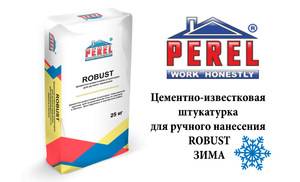 This formulation is popular for use in damp rooms. The main compound solution is cement grades from mm 150 to mm 500. For internal work use a brand with a small indicator, and for external - with a large indicator.
This formulation is popular for use in damp rooms. The main compound solution is cement grades from mm 150 to mm 500. For internal work use a brand with a small indicator, and for external - with a large indicator.
Sand is an additional component of the solution. Recommended ratios of elements are 1: 3 or 1: 4 parts of sand. For large layers of leveling, it is better to purchase mixtures with medium-grained sand. After drying, such a mixture will not crack, and compositions with fine-grained sand are used for final work. Suitable for outdoor work.
To improve the quality of the solution, manufacturers use various additives. This combination of composition allows for improved strength, elasticity, frost and moisture resistance.
Cement-lime plaster
This mixture is one of the most popular in repair work. Cement-lime plaster is easier to work with than sand mix. It is more plastic, better adheres to the surface and is vapor-permeable. But in terms of strength it is inferior to sand batch.
The composition of this solution includes: cement, slaked lime, quartz sand, polyoxymethyline, polypropylene fiber. This composition is well resistant to the development of fungus and moldiness. Available in powder and diluted form. This solution is used for interior work or only for cladding buildings. Prepare the batch for work only according to the manual in order to avoid deterioration in the properties of the composition.
Positive traits:
- Used for all known wall surfaces.
- Adheres well to the surface when applied.
- Possesses antibacterial properties.
- The solution does not set for a long time after dilution, which allows long-term work.
- Maintains the humidity level in the room.
- The surface treated with mortar has a long service life.
What you should pay attention to when making a cement-sand mortar according to GOST
Professional builders focus on the following nuances:
- using only high-quality lime;
- the expediency of performing a test batch;
- adding water in portions while mixing;
- using proven proportions;
- compliance with safety requirements when extinguishing;
- performing kneading immediately before applying the composition;
- mandatory sifting of dry ingredients.
Observing these recommendations, you can prepare a high-quality solution on your own, saving financial resources. When preparing the lime composition, one should be guided by the requirements of the standard, use high-quality ingredients.
Peculiarities
A mortar with a cement-based binder adheres perfectly to brick, concrete or wood surfaces. It can be used to level the base while filling in cavities and cracks. The coating is smooth.
The cement-sand mixture is used when carrying out the following works:
- Facade decoration.
- Plastering of rooms in which no heating systems have been installed, as well as in rooms with high humidity.
- Carrying out repair work to seal potholes outside or inside the building.
- Leveling substrates with significant defects.
- Preparation of surfaces for tiling.
If there is moisture in the room, mold may develop on the plaster. In this case, additional treatment with antifungal compounds is required.
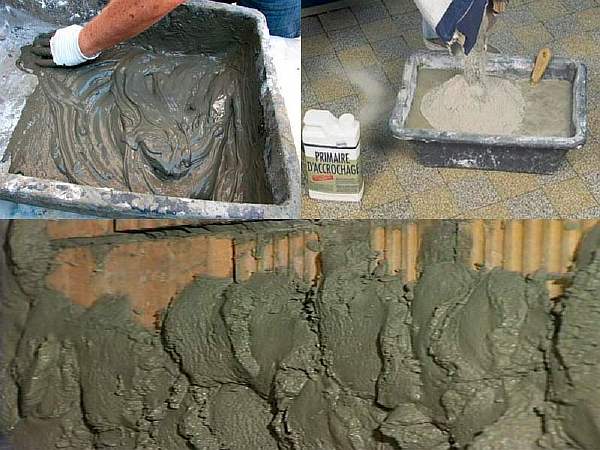 Kneading stages
Kneading stages
Cement-lime plaster mortar is best used for finishing stone, as well as wooden, bases, since a composition of cement and sand will not adhere well.
pros
Cement mortar for plaster has unique advantages. These include:
- Providing ideal coating strength. This is especially noticeable when compared with plaster, that is, the latter will not be difficult to crumble, and the former is unlikely to succumb to such efforts.
- Increased resistance to high humidity and temperature extremes.
- The durability of the composition. This is noticeable when finishing the facade, and these surfaces are most susceptible to unfavorable external environmental factors. If you plaster the base with cement mortar, it is guaranteed that the building will be preserved for at least 15 years.
- Excellent adhesion of the compound to surfaces such as brick, stone, concrete base and cinder block.
- Affordable prices. The cost of a dry plaster mix is about 20% lower than a gypsum mix, and if you mix it yourself, it will accordingly be even cheaper at least twice.
 Sealing of seams
Sealing of seams
Cement is always commercially available and is considered a cheap as well as an affordable material.
Minuses
The advantages of cement plaster mixtures are considered, however, there are a number of disadvantages:
- If the composition turned out to be thick, then this creates certain difficulties when working with it.
- After cement plastering and full curing, its surface will definitely turn out to be rough. If it is planned to glue wallpaper or paint, then it is necessary to additionally finish the treatment with plaster.
- When developing design documentation, it should be taken into account that the load on the foundation from the composition of the cement-sand mixture will increase, that is, it turns out that it is necessary to first calculate which foundation to lay.
- If the surface is poorly prepared for plastering, including painted or there are no notches on the base, the plaster will not adhere.
- When applying the composition to the gypsum surface, the applied layer will simply tear it away from the base.
- It should be borne in mind that the plaster shrinks, that is, if a very thin layer is applied, it can quickly crack. The layer must be at least 5 mm and maximum 30 mm. When it is necessary to plaster with a thicker layer, you should first fill the mesh, and then apply the composition three times.
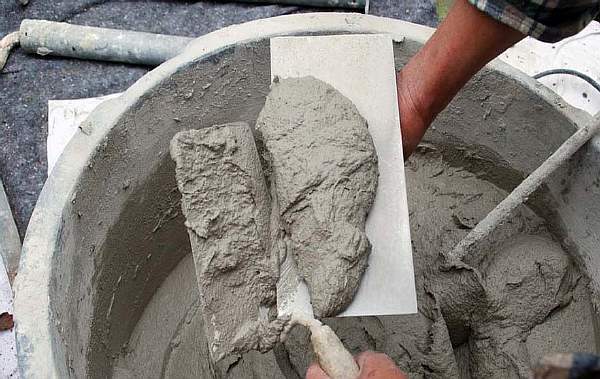 In progress
In progress
Proportions and materials
Many people know about the brand of the solution, but not everyone knows what it is. This concept is conditional and depends on a number of factors. This indicator is determined on the basis of a series of data.
On a special test bench, observations of its condition are carried out for 28 days. As a sample, a small block of plaster mix is made, which is then tested for compression.
By changing the ratio between the binder and filler, the permissible degree of the indicator is regulated. But such difficulties are needed only in large-scale construction, and in ordinary activities they are guided by the brand of cement.For example, 4 parts of sand are taken if the brand of cement is 400, and 5 parts - if 500. This is a generally accepted rule that gives average values.
The table of materials used is presented below.
 Component ratio table
Component ratio table
Mixture compositions in proportions for cement-sand mortars:
- for the first layer - spraying - put from 2.5 to 4 parts of sand on 1 part of cement;
- for the main - primer coating - take from 2 to 3 parts of sand to 1 part of cement;
- for finishing, or finishing, 1 part of cement is laid from 1.5 to 2 parts of sand.
Compositions of cement-lime mixtures:
- For spraying, 1 part of cement is taken, from 0.3 to 0.5 parts of lime and from 3 to 5 parts of sand.
- For a primer, you need to take 1 part of Portland cement, from 0.7 to 1 part of lime, from 2.5 to 4 parts of sand.
- For the finishing layer (grouting), 1 part of cement is prepared, from 1 to 1.5 parts of lime and from 2.5 to 4 parts of sand.
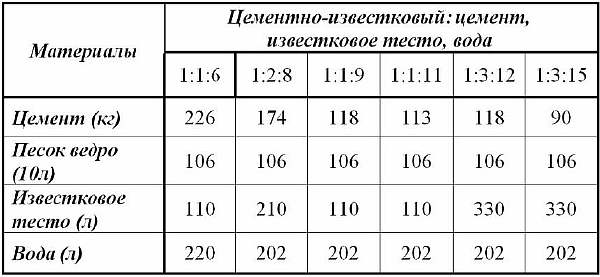 Mix recipe
Mix recipe
If the plaster is clay-sandy, then 4 parts of clay and from 6 to 12 parts of sand are taken for 1 part of cement. By varying the changes in the proportions, it is possible to both enhance and weaken the characteristics of the strength of the solution.
Varieties of solutions
Depending on the intended purpose and qualities, all mixtures for brickwork are divided into universal and special. The first type is used in the construction of structures from all types of wall stone and their cladding. It includes simple cement-based mortars (with small additions of lime), complex compositions of Portland cements and polymer additives, and decorative color mixtures. All of them, in turn, have different characteristics of mobility, adhesion, thermal conductivity and water absorption.
Complex masonry mortars are represented by compositions with the addition of refractory materials or fillers that increase resistance to aggressive media. They are used in the construction of facilities with non-standard operating conditions: chimneys, ventilation ducts, industrial premises. As for the universal variety, all their norms and characteristics are regulated by GOST 28913-98.
Depending on the composition, there are:
- Cement mortars for brickwork are hard and inactive, but with a strength suitable for the construction of structures with high loads.
- Lime mixtures are highly elastic and warm (minimum coefficient of thermal conductivity), but rarely used due to their brittleness after hardening. Their compressive strength is 0.4 MPa, which is unacceptable for load-bearing walls. The scope of application is limited to interior work in low-rise buildings, these are rather general construction mortars, rather than masonry ones.
- Mixes of sand and cement with the addition of lime milk in small proportions are universal formulations with excellent adhesion and mobility. But with all the advantages, they are not used when there is a risk of intense exposure to moisture on the masonry.
- Cement-clay mortars are slightly inferior in strength to the first variety, but gain in elasticity. They are convenient in laying, but difficult to prepare: you need not only to purchase clay with a suitable fat content, but also thoroughly knead all the lumps.
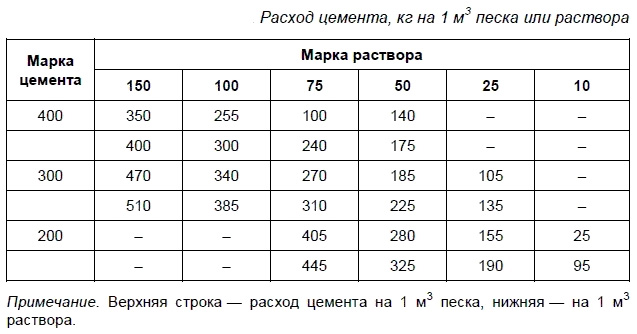
The classic masonry mixture of cement and sand is optimal for the laying of load-bearing and foundation structures of houses. Adhere to the following proportions:
Recommended area of application
For the laying of furnaces and refractory structures, simple solutions are used, prepared by hand, based on clay, or complex mixtures with cement, lime or chamotte chips. The water ratio does not exceed 0.25 parts of the clay volume. The exact proportions of sand depend on the fat content of the binder and vary from 1: 1 to 1: 2. When mixing cement-clay mortar, they are: 0.15: 1: 3 or 0.2: 1: 5, respectively.
Truly working legal way to save money. Everyone needs to know this!
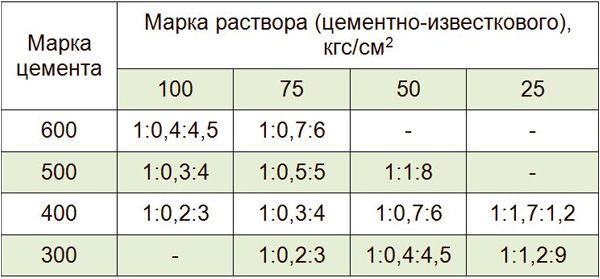
Dry plaster cement-sand mixtures (GOST 28013-98) - mixing technology
For the preparation of the lime composition, the following ingredients are required:
Portland cement;
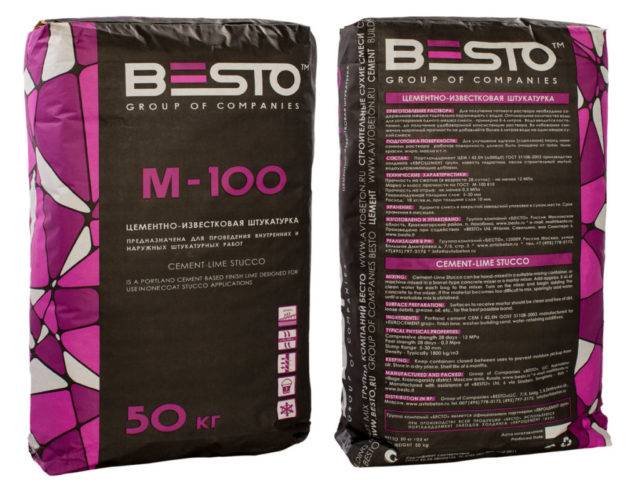
Masonry mortar for bricks is not picky and coarse sand is used in its production, and plaster mortar does not accept coarse abrasive materials
- fine sand;
- slaked lime.
You also need water, which is added during mixing. To improve the characteristics, modifiers are introduced. Lime is introduced in different consistencies:
- powdery. Slaked material in the form of a white powder is also called fluff by builders;
- pasty. Lime dough is formed by the reaction of water with quicklime in a ratio of 1: 2;
- liquid. When lime is diluted with water in a 1: 1 ratio, the so-called milk of lime is formed.
For example, on the basis of cement grade M400, you can prepare different mixtures:
- the composition of the M75 brand is prepared by mixing Portland cement, sand and lime, in a ratio of 2: 10: 1;
- mixture M50 contains a reduced amount of cement, which is mixed with sand and lime in a ratio of 1: 8: 1.
The proportions of the components are associated not only with the brand of cement, but also differ for different mixtures. So, lime mortar grade 4, the technical characteristics of which are rather low, is prepared on the basis of low grade cement. This, accordingly, is reflected in the strength. And the most durable composition of the M200 brand requires the use of high-quality cement.
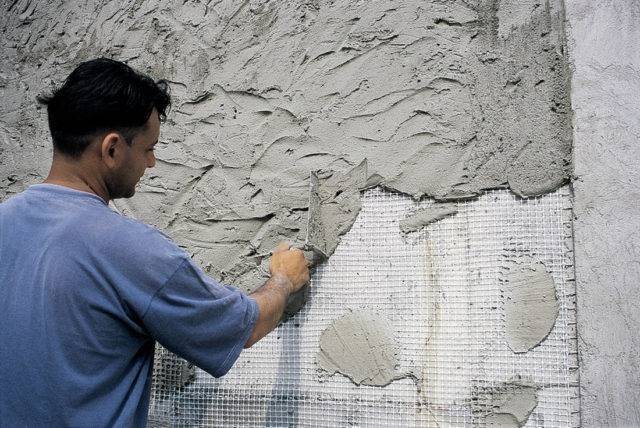
When mixing plastering material for walls, the proportion of fine-grained sand should be carefully controlled.
To carry out the work, it is necessary to prepare equipment and tools:
- concrete mixer that allows mixing increased volumes;
- container for components used for manual mixing;
- an electric drill with a stirring attachment, which makes work easier;
- a sieve for separating foreign inclusions;
- buckets and shovels for loading components during mixing.
The algorithm for performing the batch is quite simple:
- Deliver all components to the site in the quantities required to prepare the correct grade of lime mortar.
- Prepare the solution by mixing slaked lime with water. Add water to a milky consistency, remove the remaining lumps with a sieve.
- Mix Portland cement with pre-sieved river sand until a uniform consistency is achieved.
- Enter the milk of lime into the resulting composition, mix again. If thick, add water gradually.
An alternative option is possible, which is easy to implement on your own:
- Mix dry lime with sifted sand.
- Add cement to the dry mixture, mix the ingredients.
- Add water in the required volume to the required condition.
This technology makes it possible to prepare compositions not only for masonry, but also for plastering.
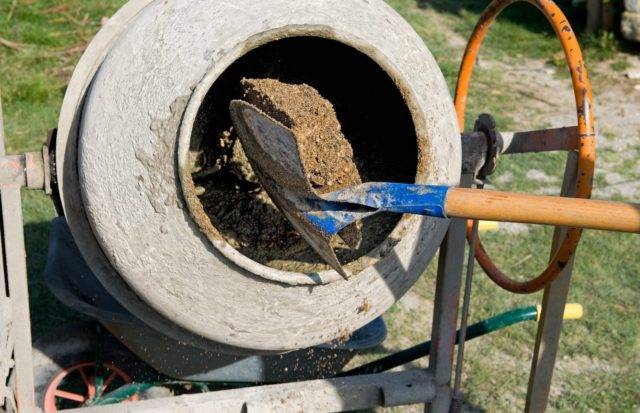
Lime mortar based on slaked lime is used in the decoration of premises where there is high air humidity
The difference between the mixtures lies only in the ratio of the components used:
- masonry mortars contain cement, one part of which is added from 2.5 to 8 parts of sand and 0.1–0.9 parts of lime;
- for 1 part of cement in various types of plaster compositions, 1.5–2.5 parts of sand and 0.2–0.3 parts of lime are taken.
When performing important work, it is necessary to use only a proven recipe.
